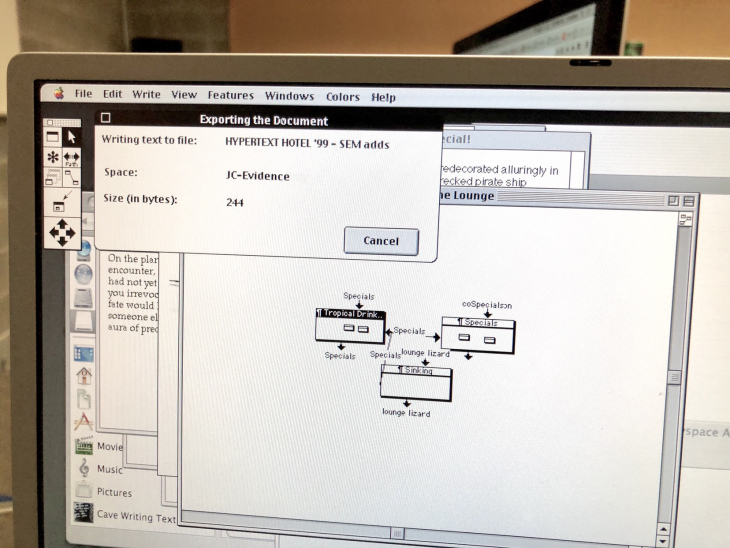The Hypertext Hotel
NOTE: This was the original introduction I wrote for the Hypertext Hotel project I
participated in while a student at Southern Oregon Univeristy in the Emerging Media and Digital Art program.
The work I did during the project is tricky to sumarize out of the historical context of the the orginal
Hypertext Hotel (born in a class taught by Robert Coover at Brown University in 1990) and its place in
experimental digital literature. My main job was to help
document,
promote, and organize the original work and the new work being done by the team restoring and revisiting the
hotel from an exploration of contemporary digital arts possibilities (i.e. VR, digital design, or new
nonlinear writing tools like Twine). In this revisiting of the orginal text, we attempted to honor its
spirit while utilizing these new tools and technologies.
This writing can serve as a sample of my
writing while
providing context for other work I contributed, like being funded to travel to Brown University and
present the
restoration at the International Fiction Now Conference in 2018.
WRITING SAMPLE: Here is an
article
I wrote after this introduction, detailing the work done by the
VR experts I had the pleasure of working with.
For more context and visuals, here is a website
created to provide insight on the final restorations and process.
Beginnings 4.27.2018
The Hypertext Hotel (HH) was a metaphor used to generate collaboration between students in the first class
ever taught on hypertext fiction. The class was taught by America’s grandmaster of postmodern fiction,
Robert Coover, the year was 1990, and soon even the most skeptical creative writing students at Brown
University found writing with Storyspace (a predecessor to Twine, a popular nonlinear storytelling tool that
I highly recommend playing around with) to be a generative and pleasurable experience. Collaboration between
students was key in the HH and the guestbook boasts a laundry list of creative masterminds from outside of
the classroom who had an equal hand in its creation.

The contributions most often consisted of the telling of mysterious and nefarious activities in the various
rooms of the hotel perpetrated by a new character. Sometimes additions were in fact destructive through the
revision of other’s creations or of volatile character interactions ending in possibly even death. As a
result, the environment was set to anarchic, creative freedom— a wild place to stay where there were no
promises, no expectations, and no order beyond the limits of the software generating new sections of
interlinked hypertext.
Back when, the HH also made its way onto the pages of The New Yorker and The New York Times Book Review (See
Robert Coover’s The End of Books, an excellent, firsthand overview, and The New Yorker’s The Pleasures of
(Hyper)text).
Sadly, and against the intentions of its creator, the HH has remained largely inactive for the past
twenty-plus years after a solid run through the early 90s.
In response, Professor Bobby Arellano, founder of Southern Oregon University’s Emerging Media and Digital
Art (EMDA) major—also a former student and professor and hypertext innovator under Coover at Brown during
the first days—and a team of multidisciplinary students in his EMDA practicum class, including this humble
reporter, began the task of recovering the Hotel to its former glory. In addition to finding and restoring
the text, we also decided to also add a touch of contemporary tech such as cardboard VR environments (made
of 360 photos taken here) and a hypercool drone-shot promo video.
But alas, our dream had a bumpy translation into reality.
The first roadblock came in the form of error messages hidden behind a discouragingly high percentage of the
dusty HH links.

After some weeks of Professor Arellano asking around Brown University’s archives to no avail, the dream
began looking bleak. One sunshiny morning, however, good news from professor Coover himself was delivered to
Bobby’s inbox: an old laptop, possibly containing all of the original HH files, was found lying somewhere
around Providence, RI. It had actually been used for the past ten years (at least) as a miniature table for
newborn babies to have miniature tea parties. After several cycles of babies, it was realized to be in fact
one of the last accessible computers containing the HH files we had been so desperately desiring.
One more problem though: the password had been forgotten, lost under a wrinkle in time.
After retrieving the laptop from Brown, Professor Arellano was able to recruit an on-campus IT specialist to
unlock it, and voila! We were granted access to every original file, plus some unpublished HH writing from
Robert Coover and others.

The next step, the fun one, was to transfer all of the text to Twine for a stable, modern reboot and, of
course, carry the legendary HH legacy into a new era of electronic literature.